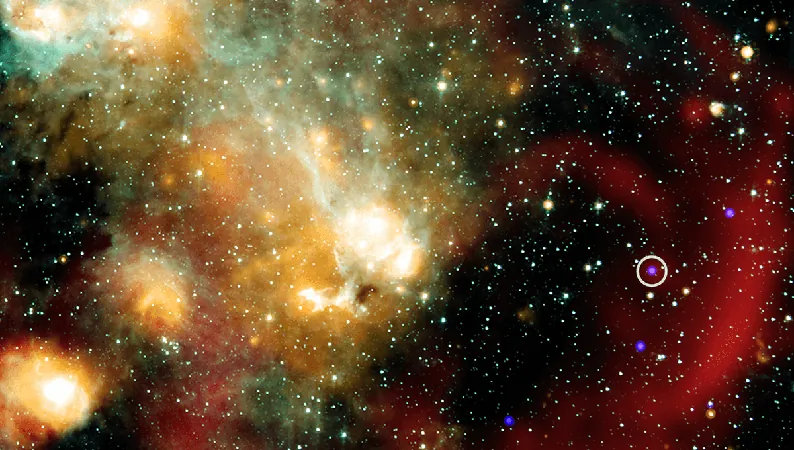
Unraveling Cosmic Mysteries: Astronomers Stumble Upon Intriguing Signal from Deep Space!
2025-06-02
Author: Arjun
Astronomers Discover a Cosmic Enigma!
In a groundbreaking development, Australian astronomers from CSIRO have captured a bizarre cosmic signal using the ASKAP radio telescope, located on Wajarri Country. The source, intriguingly dubbed ASKAP J1832-0911, emits bursts of radio waves every 44 minutes, setting it apart from anything previously observed.
What Are Long-Period Transients?
Long-period transients (LPTs) represent a newly categorized class of celestial phenomena. Unlike the rapid pulses from pulsars, these objects emit bright flashes over intervals ranging from several minutes to hours. According to lead researcher Ziteng (Andy) Wang, these mysterious LPTs leave scientists puzzled since ASKAP J1832-0911 doesn’t resemble any known stars or cosmic systems in our galaxy or beyond.
A Dual Discovery: X-ray Signals Intensify the Mystery!
Adding another layer of intrigue, researchers noted a correlation between the radio signals and high-energy X-ray emissions detected by NASA's Chandra X-ray Observatory, which fortuitously observed the same region of the sky. The presence of higher-energy X-rays raises essential questions about what triggers these signals and their unexpected 'on-off' behavior.
Unprecedented Brightness Sparks Excitement!
Digging through prior observations, the team uncovered no evidence of ASKAP J1832-0911 before their initial detection, suggesting a powerful event triggered its sudden activation. Remarkably, in February 2024, the object showed a significant increase in brightness, achieving a level previously seen in fewer than 30 objects throughout the cosmos.
Theories Galore: Magnetar or Binary Stars?
With its dazzling brilliance, ASKAP J1832-0911, located 15,000 light-years away in the Milky Way’s plane, poses a challenge to existing astrophysical models. Dr. Wang speculates it could be a magnetar — the core of a deceased star with intense magnetic fields — or perhaps a binary star system, wherein one star is a highly magnetized white dwarf. Despite these theories, the enigma surrounding this object remains unsolved, hinting at possible new physics or stellar evolution models.
A Glimpse into a Hidden Universe?
Though unique, this discovery opens the door to the possibility that other LPTs might also emit X-rays. Professor Nanda Rea emphasizes that identifying ASKAP J1832-0911 could mean there are many more such objects lurking in the universe, waiting to be uncovered.
The Quest for Cosmic Knowledge Continues!
The research team is committed to unraveling the mysteries of this intriguing cosmic signal and plans to continue searching for similar phenomena. Dr. Tong Bao reflects on the excitement of scientific inquiry, stating, "Finding a mystery like this isn’t frustrating — it’s what makes science thrilling!" Stay tuned as astronomers dive deeper into the cosmos to ignite our understanding of the universe.



 Brasil (PT)
Brasil (PT)
 Canada (EN)
Canada (EN)
 Chile (ES)
Chile (ES)
 Česko (CS)
Česko (CS)
 대한민국 (KO)
대한민국 (KO)
 España (ES)
España (ES)
 France (FR)
France (FR)
 Hong Kong (EN)
Hong Kong (EN)
 Italia (IT)
Italia (IT)
 日本 (JA)
日本 (JA)
 Magyarország (HU)
Magyarország (HU)
 Norge (NO)
Norge (NO)
 Polska (PL)
Polska (PL)
 Schweiz (DE)
Schweiz (DE)
 Singapore (EN)
Singapore (EN)
 Sverige (SV)
Sverige (SV)
 Suomi (FI)
Suomi (FI)
 Türkiye (TR)
Türkiye (TR)
 الإمارات العربية المتحدة (AR)
الإمارات العربية المتحدة (AR)